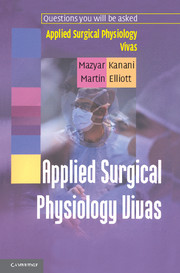Book contents
- Frontmatter
- Contents
- List of Abbreviations
- Dedication
- Preface
- A Change in Posture
- Acid-Base
- Action Potentials
- Adrenal Cortex I
- Adrenal Cortex II – Clinical Disorders
- Adrenal Medulla
- Arterial Pressure
- Autonomic Nervous System (ANS)
- Carbon Dioxide Transport
- Cardiac Cycle
- Cardiac Output (CO)
- Cell Signalling
- Cerebrospinal Fluid (CSF) and Cerebral Blood Flow
- Colon
- Control of Ventilation
- Coronary Circulation
- Fetal Circulation
- Glomerular Filtration and Renal Clearance
- Immobilization
- Liver
- Mechanics of Breathing I – Ventilation
- Mechanics of Breathing II – Respiratory Cycle
- Mechanics of Breathing III – Compliance and Elastance
- Mechanics of Breathing IV – Airway Resistance
- Microcirculation I
- Microcirculation II
- Micturition
- Motor Control
- Muscle I – Skeletal and Smooth Muscle
- Muscle II – Cardiac Muscle
- Nutrition: Basic Concepts
- Pancreas I – Endocrine Functions
- Pancreas II – Exocrine Functions
- Potassium Balance
- Proximal Tubule and Loop of Henle
- Pulmonary Blood Flow
- Renal Blood Flow (RBF)
- Respiratory Function Tests
- Small Intestine
- Sodium Balance
- Sodium and Water Balance
- Starvation
- Stomach I
- Stomach II – Applied Physiology
- Swallowing
- Synapses I – The Neuromuscular Junction (NMJ)
- Synapses II – Muscarinic Pharmacology
- Synapses III – Nicotinic Pharmacology
- Thyroid Gland
- Valsalva Manoeuvre
- Venous Pressure
- Ventilation/Perfusion Relationships
Nutrition: Basic Concepts
Published online by Cambridge University Press: 06 January 2010
- Frontmatter
- Contents
- List of Abbreviations
- Dedication
- Preface
- A Change in Posture
- Acid-Base
- Action Potentials
- Adrenal Cortex I
- Adrenal Cortex II – Clinical Disorders
- Adrenal Medulla
- Arterial Pressure
- Autonomic Nervous System (ANS)
- Carbon Dioxide Transport
- Cardiac Cycle
- Cardiac Output (CO)
- Cell Signalling
- Cerebrospinal Fluid (CSF) and Cerebral Blood Flow
- Colon
- Control of Ventilation
- Coronary Circulation
- Fetal Circulation
- Glomerular Filtration and Renal Clearance
- Immobilization
- Liver
- Mechanics of Breathing I – Ventilation
- Mechanics of Breathing II – Respiratory Cycle
- Mechanics of Breathing III – Compliance and Elastance
- Mechanics of Breathing IV – Airway Resistance
- Microcirculation I
- Microcirculation II
- Micturition
- Motor Control
- Muscle I – Skeletal and Smooth Muscle
- Muscle II – Cardiac Muscle
- Nutrition: Basic Concepts
- Pancreas I – Endocrine Functions
- Pancreas II – Exocrine Functions
- Potassium Balance
- Proximal Tubule and Loop of Henle
- Pulmonary Blood Flow
- Renal Blood Flow (RBF)
- Respiratory Function Tests
- Small Intestine
- Sodium Balance
- Sodium and Water Balance
- Starvation
- Stomach I
- Stomach II – Applied Physiology
- Swallowing
- Synapses I – The Neuromuscular Junction (NMJ)
- Synapses II – Muscarinic Pharmacology
- Synapses III – Nicotinic Pharmacology
- Thyroid Gland
- Valsalva Manoeuvre
- Venous Pressure
- Ventilation/Perfusion Relationships
Summary
1. What are the body's sources of energy? How much energy does each supply?
Glucose: provides 4.1kcalg−1
Fat: 9.3kcalg−1
Protein: 4.1kcalg−1
2. What is meant by the respiratory quotient?
This is defined as the ratio of the volume of CO2 produced to the volume of oxygen consumed from the oxidation of a given amount of nutrient. Values for the different energy sources are:
Carbohydrayte: 1.0
Fat: 0.7
Protein: 0.8
3 What is the recommended daily intake for protein and nitrogen?
Protein: 0.80 gkg−1
Nitrogen: 0.15 gkg−1
4. What is an essential amino acid? How many are there, and give some examples?
These are amino acids that cannot be synthesised by the body and need to be ingested. There are 9 of them; leucine, isoleucine, lysine, methionine, phenylalanine, threonine, tryptophan, histidine and valine.
5. What are the main carbohydrates in the diet?
Direct carbohydrate is composed mainly of the polysaccharide starch, some disaccharides such as sucrose and fructose and a small amount of lactose. Other important polysaccharides include cellulose, pectins and gums. These are not digested, and make up the roughage in the diet.
6. In what form is fat stored in the body?
As triglycerides.
7. What are these composed of?
These consist largely of long chain saturated and unsaturated fatty acids (predominantly palmitic, stearic and oleic acids) that have been esterified to glycerol.
8. What is an essential fatty acid? Which ones are there, and why are they particularly important?
These are fatty acids that cannot be synthesised in the body.
- Type
- Chapter
- Information
- Applied Surgical Physiology Vivas , pp. 108 - 110Publisher: Cambridge University PressPrint publication year: 2004



